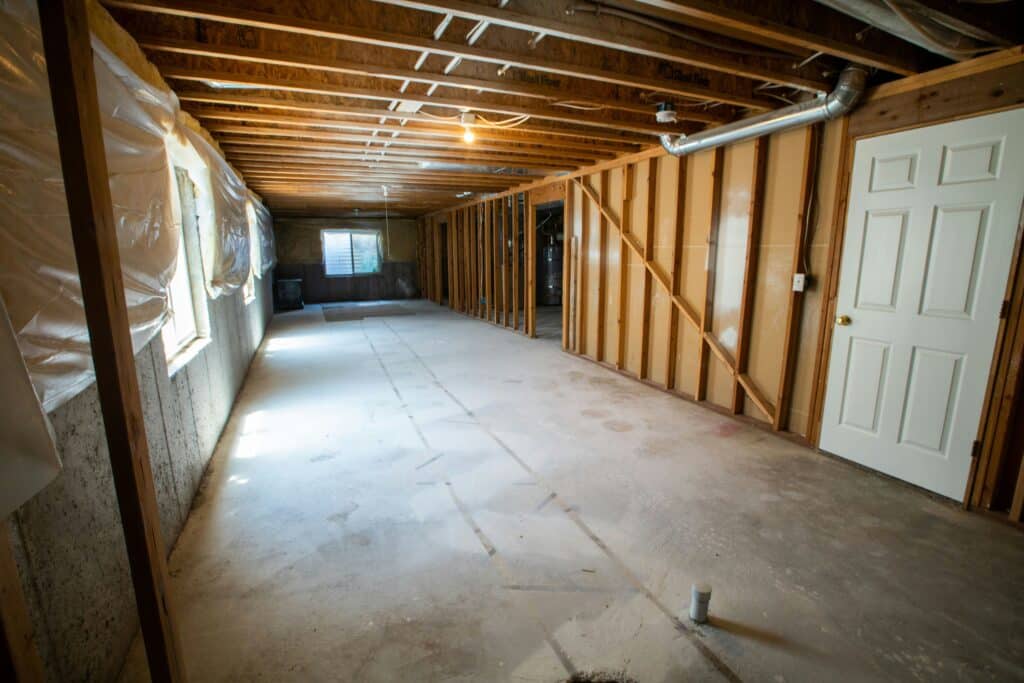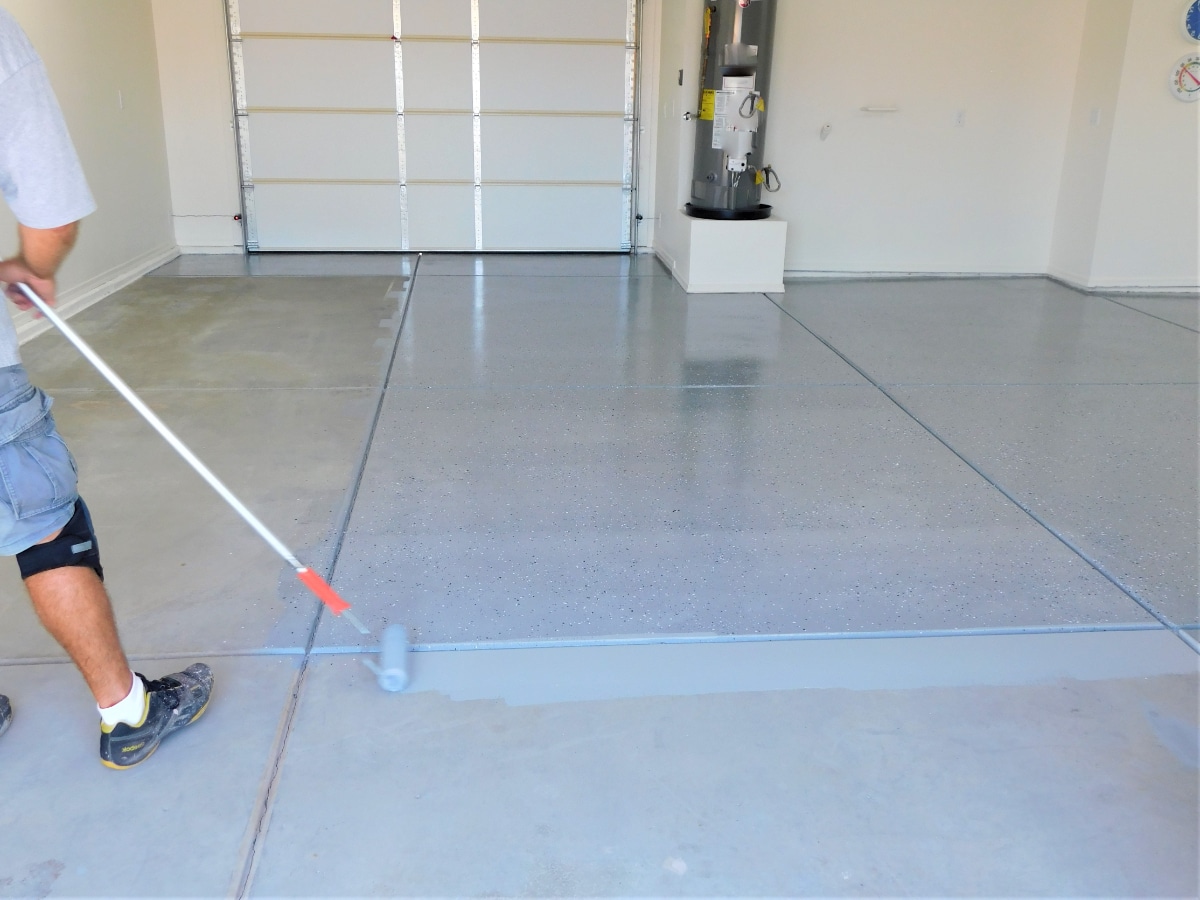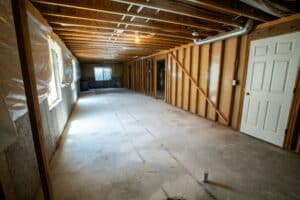Ever wondered how long concrete paint actually holds up––and whether it’s low price and DIY-friendliness is worth it?
In this article, we’ll dig into the key factors that influence its durability and share a few practical tips to help your paint job go the distance. Or, make the switch to a more durable solution…
What Impacts How Long Concrete Paint Lasts?
A lot goes into how long concrete paint can keep looking sharp. Let’s break down the biggest factors:
1. The Traffic It Sees
Think about it: a busy garage full of cars and heavy gear is going to beat up your paint much faster than a quiet patio with only the occasional footsteps. The more wear and tear, the quicker it’ll start to fade or produce paint chips.
2. The Prep Work Before Painting
This is a big one. Skipping out on cleaning or priming the surface is like building a house without a foundation—it’s bound to fail. Taking the time to prep properly means the paint sticks better and lasts longer. The same is true for all concrete coatings.
3. The Type of Paint You Use
Not all paints (and certainly not all coatings) are made equal! Some are tough enough to handle the weight of cars and machinery, while others can barely withstand everyday foot traffic. Choosing a high quality product can make all the difference.
Types of Concrete Paints and Coatings: Which One Lasts Longer?
Not all concrete paints and coatings are equal. While concrete paint is the cheapest option, it is also the least durable.
For a longer-lasting solution, epoxy and polyurea coatings (the base coat to a polyaspartic coating) offer superior performance. Epoxy coatings can last 10-15 years with proper application and are resistant to stains, chemicals, and hot tire marks or pickup and delaminating, making them ideal for high-traffic areas like garages.
Polyurea coatings offer superior durability and UV stability compared to epoxy, too, preventing yellowing in sunlight. They are also more resistant to tire stains and can withstand a wider range of chemicals.
Regular floor paint is generally not recommended for concrete due to its poor durability––it won’t last long in garages or anywhere that gets significant foot traffic. While it may be economical initially, it can require frequent reapplication, making it less cost-effective long-term. Plus, that’s a hassle!
Traffic: The Ultimate Test for Concrete Paint
If your concrete floor takes a lot of punishment from cars, heavy tools, or foot traffic, expect the paint to show wear much sooner.
Garages, warehouses, and other busy spaces tend to see chipping or peeling within 1–2 years without heavy-duty coatings. Hot tires are another sneaky culprit—they speed up deterioration, leaving unsightly marks or patches.
Choosing a traffic-resistant paint or coating is the best way to keep high-traffic areas looking sharp.
Environmental Exposure and Its Effects
Moisture, sunlight, and temperature swings all play a part in how well your paint holds up:
- Moisture infiltration can cause premature paint failure through peeling or bubbling. Filling cracks and imperfections before painting prevents moisture from compromising the paint.
- Sunlight and chemicals also affect the durability of concrete coatings. UV exposure can cause some paints to yellow and degrade. Using UV-resistant materials mitigates this issue and enhances paint longevity.
- Temperature Fluctuations: Extreme changes in weather can weaken the bond between paint and concrete, leading to cracks or chips.
To protect your surfaces, opt for coatings designed to handle these challenges head-on.
Prep Work: The Secret To a Durable Paint Job
The key to a paint job that lasts? Nailing the prep work. Here’s how to properly prepare and do it right:
Cleaning Your Concrete Surface
The first step in preparing a concrete surface for painting is thorough cleaning. Removing dirt, grease, and previous coatings creates a suitable foundation for the paint. Effective cleaning allows for better adhesion of the new paint.
Use a gentle detergent or imply pressure washing with a pressure generally not exceeding 1,750 PSI. Then, make sure it dries completely!
Prime Like a Pro
Priming the concrete floor is essential. A primer improves paint adhesion to the concrete surface, seals the surface, and prevents moisture from affecting the bond. It creates a textured surface for the top coat, contributing to a long-lasting finish.
For best results, make sure the concrete surface is completely dry before applying the primer to avoid interference. Using a primer guarantees better paint adhesion and extends the service life of your painted concrete floor.
Repairing Cracks and Imperfections
Repairing cracks and imperfections before painting prevents future paint failure and creates a smooth and stable surface for paint adhesion. Cracks and structural imperfections can compromise the paint job, leading to peeling and chipping over time.
Application Techniques for Long-Lasting Results
It’s simple: proper application techniques lead to the most durable concrete finish.
The following subsections cover some basic tools and materials, the technique of applying paint in layers, and the importance of allowing sufficient drying time between coats.
Choosing the Right Tools and Materials
For a paint job that stands up, the tools and materials you choose are crucial. Opt for top-notch brushes and rollers specifically designed for textured surfaces for a smooth application and improved durability. Tools for this project might include quality paint, a reliable primer, concrete cleaner, etching solution, caulk for sealing cracks, and tools like a pressure washer, vacuum, paint stripper, and of course cement paint.
While premium products might come with a higher upfront cost, they’re worth every penny. They deliver a tougher, more resilient finish that lasts far longer than cheaper alternatives. Combined with thorough surface preparation and the right tools, these choices are key to achieving a paint job that doesn’t just look great but holds up beautifully over time.

Applying the Paint in Layers
When it comes to achieving a lasting finish, layering is the secret sauce. Applying several thin coats of paint works far better than a single thick one. This helps the paint adhere more securely to the surface, boosting durability and resistance to peeling or chipping.
Layering also creates a smoother, more even finish, giving your concrete a polished, uniform look. By building up thin coats gradually, you’ll enhance the paint’s coverage and create a stronger, longer-lasting bond.
Allowing Sufficient Drying Time
Patience pays off when it comes to painting concrete. Giving each layer ample drying time before applying the next can make for a longer-lasting finish. This waiting period allows the paint to properly bond with the surface.
For oil-based paints, a minimum of 16 hours between coats can help with proper adhesion. Taking the time to let each layer set not only strengthens the overall bond but also helps prevent future damage, making your paint job more resilient in the long run.
Comparing Concrete Paint to Other Coating Options
When weighing concrete paint against other coating options, durability and performance take center stage. While paint provides a quick and affordable fix, it falls short in longevity. For a finish that stands up to wear and tear, epoxy and polyaspartic coatings are far superior and ideal for areas with heavy use.
Epoxy coatings are a popular option, lasting between 10-15 years on concrete surfaces when properly applied. They are resistant to stains and chemicals.
But, epoxy is no longer the best concrete coating for garages, or for most basements. Polyaspartic coatings, known for flexibility and impact resistance, offer superior protection against tire wear, foot traffic, moisture, temperature changes, and UV rays. Unlike epoxy, polyspartic does not fade or discolor. These coatings cure faster than epoxy, allowing for quicker project completion and reduced downtime, too.
The Bottom Line on Concrete Coatings
Concrete paint might seem like an easy, wallet-friendly solution to spruce up a space, but it doesn’t have the staying power of coatings like polyurea with polyaspartic coatings.
Polyurea takes durability a step further than epoxy, too, with superior UV resistance, flexibility, and the ability to withstand heavy use without fading or cracking. While paint requires frequent touch-ups, a polyaspartic coating is built to last, saving you both time and money in the long run.
Is it worth it? If you’re looking for a quick fix or a low-cost option for areas with minimal wear, concrete paint can do the trick—but for spaces that see constant traffic or exposure to the elements, investing in a polyaspartic or epoxy coating is the smarter choice. These coatings deliver exceptional longevity and require far less maintenance, making them a better value over time.
If you’re in the Finger Lakes, Everlast Concrete Coatings can help you make the best choice for your floors. With professional concrete coatings and polyaspartic options that last ten times longer than traditional paint, we’ll create a finish that not only looks stunning but withstands daily wear and tear with ease.
Contact us today for a free consultation, and let’s turn your flooring vision into a reality that lasts.





